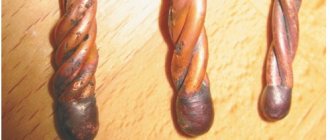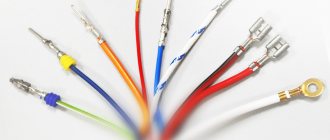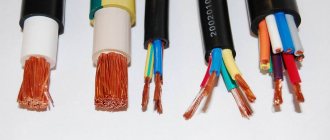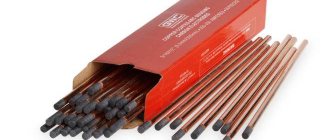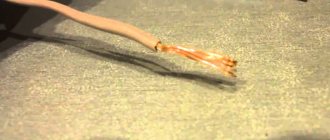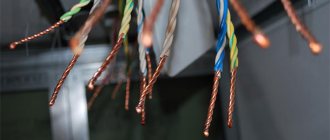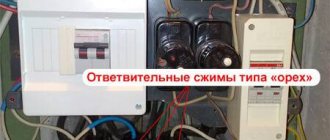When it is necessary to install or replace electrical networks inside a home, the question often arises - what type of conductor to use for this, with one monolithic core or a large number of woven metal hairs. Let's look at how stranded wire differs from single-core wire in composition, design and flexibility class, what the features of each of these types are, what to choose when it comes to organizing electrical wiring in the house, and also what methods of connecting wires exist.
Comparison of wires of the same cross-sectional area, but of different structures - single-core and multi-core Source volk1.ru
Wires - device, composition, flexibility
Conductors for installation of household electrical wiring are a copper or aluminum conductor covered with an insulating layer based on PVC, polyethylene, rubber or fluoroplastic. Moreover, according to their structure, they are divided into 2 main types:
- Single-core . These are, as a rule, rigid conductors consisting of a monolithic cylindrical or sector rod. One of the most important characteristics of electrical conductors is bending resistance. This category is characterized by the minimum value of this indicator. For example, copper products can withstand about 70-90 cycles, while aluminum analogues are not able to withstand more than 10 kinks.
- Stranded . They are a twist of a large number of thin metal hairs, the number of which can vary widely - from 7 to several hundred. Multicore wires are made according to the principle of a metal cable. Moreover, the thinner the wires included in its composition, the higher the bending resistance. For example, for copper specimens belonging to flexibility class 5, its value can reach 30 thousand cycles.
A multi-core cable is a twisting of conductors with a smaller cross-section Source habb.md
Recommendation! Using stranded wires, it is convenient to connect terminals in sockets, as well as sockets in lamps - where single-wire analogues often break. The softness and flexibility of such conductors makes it possible to use them to connect to the network various types of electrical appliances that are characterized by an unstable position during operation, such as a vibrating washing machine, a constantly moving electric stove, a drill.
Flexibility classes and their differences
Whether a conductor belongs to a particular flexibility class shows how much it can bend during operation without irreversible changes in the structure. According to this indicator, wires are graded into 6 categories. At the same time, class 1 means the highest rigidity, class 6, on the contrary, the greatest flexibility.
The flexibility class and conductor structure, as a rule, have a direct relationship. The higher the flexibility index, the greater the number of cores and vice versa.
The flexibility of the wire depends on the type and cross-sectional area Source strojdvor.ru
A good example is two wires with a cross section of 1 mm2 of the 3rd and 5th flexibility classes. The first is made of wires with a diameter of no more than 0.43 mm, the second - no more than 0.21 mm. Thus, the number of cores in a 5th class specimen will be greater than in a 3rd class analogue.
PVS or VVG
And if there is another external insulation, then can we immediately consider it a cable? No not always. This is where the mistake of many lies. A single conductor or “noodle” can be distinguished by everyone, but if there is a second shell, doubts begin.
For example, PVS, ShVVP or PUGNP are not cables at all, as some people believe, although they have external protection.
Here are the transcripts of their names:
- PVA – Wire with vinyl insulation Connecting
- SHVVP – Shnur with insulation from INinyl with a shell of INinila Psmooth
- PUGNP – Wire Universal Purpose Flexible Flat _ _ _ _
More details on the characteristics, markings and technical specifications for cables, cords and wires can be found in GOST 53768-2010.
Here is a summary comparison table of VVG cable and PVS wire. Their disadvantages and advantages.
Features of single-core and stranded wires
In order to choose a stranded or single-core wire that suits the operating conditions, as well as a suitable connection method, you must first consider the main pros and cons of each of them.
1-core conductors are classified as stationary. This means that they can only be installed in conditions where during operation they will not be subjected to various types of mechanical loads - and above all, bending.
In addition, they are characterized by the following number of features:
- Minimum resistance per kilometer of wire.
Thus, a copper monolith with a cross section of 1 mm2 has a value of about 18 Ohms. At the same time, a stranded wire of class 5 flexibility of a similar area gives a resistance of 19.5 Ohms.
1-core wire is ideal for laying electrical wiring in a groove Source samelectrik.ru
See also: Catalog of companies that specialize in electrical work of any complexity
This phenomenon occurs due to two patterns. There is a direct relationship between cross-sectional area and resistance - the smaller the first, the higher the second. In addition, although all conductors are twisted into a common core, their contact is nevertheless mechanical. Because of this, the resistance value inevitably increases.
- Ease of connection.
There are several basic options for how to connect single-core and stranded wires; consider their features for copper specimens:
- Screw . A monolithic wire for this method is more preferable than a stranded wire - the cross-section is not reduced, and individual hairs are not squeezed out of the contact point.
- Clamping . When using WAGO type terminals, a single-core wire fits perfectly, which cannot be said about a multi-core analogue.
- Welding . The monolith is welded perfectly. On the contrary, individual thin hairs are easily damaged or torn off by an arc.
- Soldering . Typically used for small cross-section conductors. In this case, preference is given to the multi-core option due to the specifics of the technology.
- Pressing . The method is difficult to implement for a large-section monolith unless special equipment is used.
Connecting a multi-core wire by pressing into a capsule Source samelectrik.ru
In addition, 1-core wire is inexpensive, which is especially important when laying a large network.
The stranded conductor, for its part, has the following number of features:
- High flexibility . This property is all the more relevant for installation, the higher the cross-sectional area.
- Ease of installation . A flexible stranded conductor or cord allows you to install electrical wiring in almost any environment.
- The need to use special tips for convenient switching. The solution is inexpensive brass connectors, the installation of which is possible without special skills.
- Possibility of easy connection using WAGO terminals after crimping.
Connecting Stranded Wires Using WAGO Terminals Source dowsingandreynolds.com
Advice! To finally understand and decide which cable is better, multi-core or single-core, it is necessary to take into account the conditions of its future operation. If you do not plan to move the electrical wiring or influence it in any way, then you can choose the 1-wire option. On the other hand, for portable equipment or when the wire will constantly change position, it is better to give preference to a multi-core modification.
Installation methods
The heating cable must ultimately be covered on all sides with mortar/tile adhesive; this can be achieved in three ways:
Fill
. The most correct way in my opinion. It consists of pouring a 1-2 cm mini-screed over the mounted cable. The resulting screed will be suitable for any floor covering. To implement this option, when pouring the main screed, you should provide a couple of centimeters of height in places where there will be a warm floor. For work, mixtures are used that allow such thin layers to be poured. If the screed is initially poured at one level and raising the floor level is unacceptable, then this method is not suitable.
Glue layer
. When the tiles are laid, and in addition to everything else, it is permissible to raise the level of the subfloor by 1-2 cm (do not forget, the tiles themselves will add at least 1 cm), the tiles are placed on top of the cable on a thick layer of glue. This option should be considered last, because there will be a significant difference at the border of the warm zone.
Grilling
. The most difficult and tedious method, however, when raising the screed level is unacceptable, is the most correct. First you need to mark the lines where the heating cable will go. You also need to take into account the groove for the corrugation with a temperature sensor and the coupling with the cold connecting cable. After marking, you need to attach some kind of thread/rope to the lines to check the length of the grooves. You need to be sure that the entire cable will fit into the future groove, otherwise you need to change the markings.
After gating, the dust is carefully removed and the surface is primed. The wire is laid in a groove; the depth of the groove should allow 3-5 mm of caulking solution to be applied over the cable.
The temperature sensor in the corrugation is also mounted in the groove; the corrugation must be plugged at the end (wrap it with electrical tape). The end of the corrugation should be placed between the heating conductors, not far from the edge of the heating zone (but not on the edge). The optimal distance of the temperature sensor is 30-50 cm from the edge, deep into the warm area.
When the wire is laid, the grooves are sealed with tile adhesive or a self-leveling floor mixture. If you plan to lay linoleum, it would be a good idea to apply a finishing layer of 1-2 mm of self-leveling floor.
Floors should be checked or used no earlier than a month after completion of all wet processes with the floor (pouring, laying tiles). Switching on earlier will not damage the cable itself, but may cause the solution/adhesive to crack.
Conclusion
- Heating cable is recommended for use with heated floors. The most preferred method of application is a direct heating system or "thin floor".
- Among all the variety of heating cables, it is best in terms of price-quality ratio to use a two-core resistive cable.
- The selection of the required cable with the required power density, its length and laying pitch are obtained as a result of calculations.
- Changing the length of a resistive cable section (except for a zonal cable) is unacceptable.
Rules for choosing between single- and multi-core wires
When choosing between a 1-core or stranded wire option, you must first take into account the conditions of their use:
- Multi-core is better suited for connecting moving devices. It is also ideal for laying in cable ducts, as it bends well when cornering.
- For standard electrical wiring, as well as in the groove, it is better to use a monolith, since during operation it remains in one position and better withstands mechanical loads.
- On automatic panels and RCDs, it is better to use a 1-core conductor, as it is well held in place and is not damaged when replacing the machine.
When assembling an electrical panel, a 1-core conductor is most often used Source samelectrik.ru
- In control panels it is permissible to install the cable version that corresponds to the type of fastening.
- For information communications (telephone, Internet, video), special single-wire conductors are used. The equipment can be powered either through a multi-core cable or through the wire itself.
- For working power tools, a cord is used - a stranded wire with a braid.
- In audio equipment, acoustics and high-frequency circuits, single-wire braided conductors or stranded soft wires are used to prevent the transfer of current to the surface of the conductor.
Bolted connection is the simplest and most reliable way to connect conductors made of different metals Source remontbp.com
On a note! Often, when installing wiring in a house for the first time or replacing it, the question arises about which wire is better - stranded or single-core - for the quality of power supply to electrical appliances. In fact, for a household electrical network with a voltage of 220 V and a frequency of 50 Hz, only the features of laying the electrical route and the conditions of its subsequent operation are decisive.
How is power calculated?
In order not to miscalculate the power, it is first determined whether the warm floor will be the main source of heating or an auxiliary one.
On a note. When performing calculations assuming an auxiliary source, you should take into account the power of the main heat source.
An approximate calculation for a two-room apartment, where, taking into account the correction coefficients for the heat transfer resistance of surfaces, the total heat consumption is 6 kW.
The logic is as follows:
- to heat 10 sq.m of living space, about 1 kW of thermal energy will be needed;
- the main heating system covers 90 percent of the area;
- underfloor heating as an auxiliary heating element requires compensation of 10 percent;
- taking into account 6 kW of total consumption, (10x6)/100 = 0.6 kW.
This calculation is correct if heated floors are installed in all rooms of the apartment.
Sometimes average values are used for calculations
- for kitchens and living areas 110-150 watts per 1 sq.m;
- for bathrooms 140-150 watts per 1 sq.m.
When choosing which underfloor heating is better, two-core or single-core, you need to take into account the level of comfortable temperature. Twin-core models heat the most intensely. Adjusting the temperature level depends on the heating time of the floor. When there are no special requirements for the microclimate, you can choose single-core modifications.
Video description
Watch in this video which is better for wiring a house – single-core or stranded wire:
- Connection strength . This is true for any electrical wiring, and even more so for installation options when the wire is under tension. In this case, the contact strength must be equal to or greater than the conductor itself.
A poor-quality connection or weak contact leads to an increase in the resistance of the circuit section and, as a result, to heating of the conductor. The latter in turn increases resistance. As a result, the contact quickly weakens and heats up excessively. This is what causes most household fires due to faulty electrical wiring.
Difference in insulation quality
But still, in any comparison, the quality of insulation comes first. It plays an important role depending on the installation conditions.
Many cables can be placed in aggressive environments in an open form without any cable ducts or corrugated sleeves.
But the wires, not even in an active environment, but only under the influence of water (rain), temperature changes or direct rays of sunlight, will gradually fail. Not to mention other extraneous influences.
Except of course SIP. But unlike cables, it cannot be laid underground, even in a pipe or corrugation.
Hence there will be a difference in price, although it would seem that both types are similar in design (with double insulation). Therefore, wires are used in buildings, closed switchgear (closed switchgear), and not on the street.
Sometimes, armored grades are used to lay cables in the ground and provide additional protection. In addition to all the layers of insulation, they have a layer of aluminum or lead sheath over the cores.
Video description
Video review of ways to connect wires:
- Pressing . The ends of the wires are pressed with special pliers and sleeves. The technology is used to connect both types of conductors, as well as their combinations.
- Welding . To use the method, a welding machine is required. The idea is to melt the ends of twisted conductors. The technology makes it possible to connect an unlimited number of conductors at one point.
- Soldering . Suitable for connecting 1-core wires of small cross-section. It is also used for multi-core cables and a combination of both types, but in this case the technology becomes somewhat more complicated.
Note! Conventional twisting is not a technically correct, much less safe, way to connect wires. Due to constant temperature exposure, the dimensions of metal conductors will fluctuate. Over time, this will lead to weakening of the contact, increased resistance and heating.
Heating cable requirements
If you rely on state standards, it is important not to forget about the following general requirements for a heating cable:
- If a heated floor system is to be used in an apartment, then it should be an additional, and not the main, source of heating.
- In wooden houses with a wooden base, you need to install a wire whose power will not exceed 2 kW.
- To heat ramps or stairs located outside the premises, a wire with a rated power of 4 kW is used.
- To install one circuit, it is necessary to use a continuous piece of cable. It is advisable to install one circuit in one room if its area does not exceed 25 m2.
- The transition of a wire from one room to another is not allowed. In the transition area it may simply break.
- To install the product, you must use only those spare parts and accessories that are sold with it.
Briefly about the main thing
Wires for arranging a household electrical network are divided according to structure and composition into 2 main types - single-core and multi-core. They differ primarily in the number of cores under the insulating layer, flexibility and operating conditions. The higher the flexibility class of the conductor, the softer the wire and the better its resistance to bending.
Single-core or stranded wiring wires can be connected in the following accessible and safe ways:
- With squeezes.
- Welding.
- By pressing.
- Soldering.
1-core wires have lower resistance and are convenient for connection in most available connection methods. Stranded ones are more flexible, but require a special approach for switching. Therefore, each of them has its own advantages in choosing for different applications.
Explanation of marking KGVVng(A)-LS
To make product selection easier, product labeling is provided. The abbreviation has its own interpretation, indicating the main characteristics of the wire.
KGV is a flexible cable with an insulating plastic polyvinyl chloride coating.
(A) – classification of fire safety indicators.
LS – low level of smoke emission during combustion.
Vng - the presence of an external plastic polyvinyl chloride coating, which is characterized by low flammability.
Types of connection
Joining by soldering and pressing has already been considered. Other methods:
- Bolted, under the washer: Tinned stranded and monolithic ends are bent into a loop, the inner diameter of which is equal to the diameter of the bolt;
- On the bolt, alternating, put on: a steel washer - a loop - another washer - a second loop - the last washer;
- This cake is held in place by a nut through a washer - a groover, which prevents the twist from loosening.
In conclusion, it must be said that connecting wires by simple twisting is not permitted by the PUE. It is recommended to use it as rarely as possible, to temporarily turn on not very critical places in the network.
Varieties by type of execution
For electrical work, wires with one, two or three cores can be used. Multicore samples are also known. Copper products can take different forms:
Flat with two or three monolithic cores. They have double insulation and are mainly laid under a layer of plaster.
Round in shape with three monolithic cores having a triple type of insulation. Suitable for laying under screed. Above-ground and underground placement in pipes is possible.
Round stranded copper wire. They have a triple type of insulation protection.
In addition to the insulating layer, the cable can have an additional method of protection. This is due to the purpose of use and scope of application. For example, products are manufactured with armor, heat- and water-resistant wire, with protection from external pressure.
The cores can have one color or be multi-colored. The last method is the color marking method. For example, a red, black or brown coating has a phase component, a light blue one has a “zero” component, and a yellow or green coating has a ground component. But in single-color models, identification is carried out by location - the core in the center is grounding.
